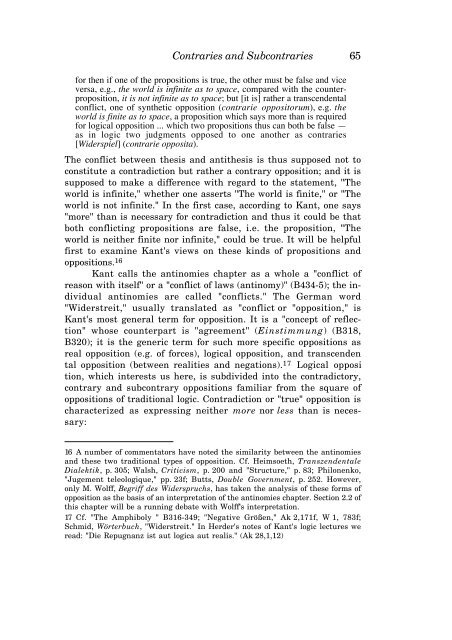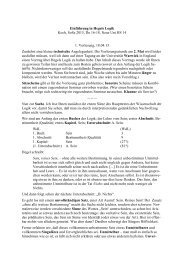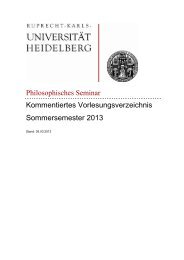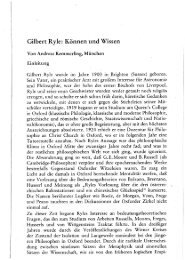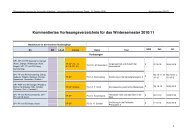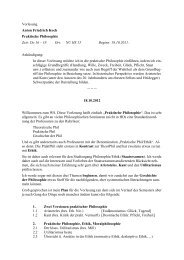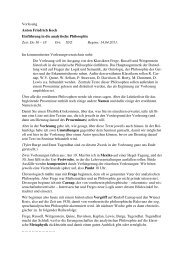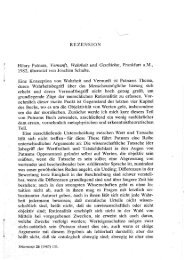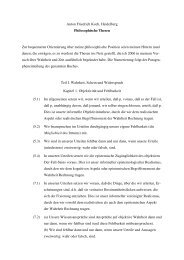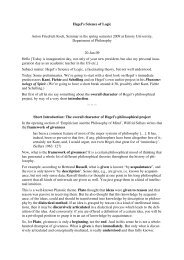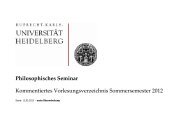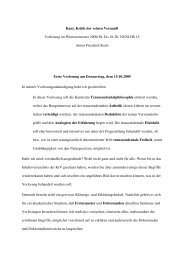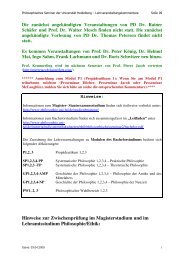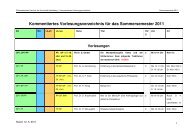KANT'S CRITIQUE OF TELEOLOGY IN BIOLOGICAL EXPLANATION
KANT'S CRITIQUE OF TELEOLOGY IN BIOLOGICAL EXPLANATION
KANT'S CRITIQUE OF TELEOLOGY IN BIOLOGICAL EXPLANATION
Create successful ePaper yourself
Turn your PDF publications into a flip-book with our unique Google optimized e-Paper software.
Contraries and Subcontraries 65<br />
for then if one of the propositions is true, the other must be false and vice<br />
versa, e.g., the world is infinite as to space, compared with the counterproposition,<br />
it is not infinite as to space; but [it is] rather a transcendental<br />
conflict, one of synthetic opposition (contrarie oppositorum), e.g. the<br />
world is finite as to space, a proposition which says more than is required<br />
for logical opposition ... which two propositions thus can both be false —<br />
as in logic two judgments opposed to one another as contraries<br />
[Widerspiel] (contrarie opposita).<br />
The conflict between thesis and antithesis is thus supposed not to<br />
constitute a contradiction but rather a contrary opposition; and it is<br />
supposed to make a difference with regard to the statement, "The<br />
world is infinite," whether one asserts "The world is finite," or "The<br />
world is not infinite." In the first case, according to Kant, one says<br />
"more" than is necessary for contradiction and thus it could be that<br />
both conflicting propositions are false, i.e. the proposition, "The<br />
world is neither finite nor infinite," could be true. It will be helpful<br />
first to examine Kant's views on these kinds of propositions and<br />
oppositions. 16<br />
Kant calls the antinomies chapter as a whole a "conflict of<br />
reason with itself" or a "conflict of laws (antinomy)" (B434-5); the individual<br />
antinomies are called "conflicts." The German word<br />
"Widerstreit," usually translated as "conflict or "opposition," is<br />
Kant's most general term for opposition. It is a "concept of reflection"<br />
whose counterpart is "agreement" (Einstimmung) (B318,<br />
B320); it is the generic term for such more specific oppositions as<br />
real opposition (e.g. of forces), logical opposition, and transcenden<br />
tal opposition (between realities and negations). 17 Logical opposi<br />
tion, which interests us here, is subdivided into the contradictory,<br />
contrary and subcontrary oppositions familiar from the square of<br />
oppositions of traditional logic. Contradiction or "true" opposition is<br />
characterized as expressing neither more nor less than is necessary:<br />
16 A number of commentators have noted the similarity between the antinomies<br />
and these two traditional types of opposition. Cf. Heimsoeth, Transzendentale<br />
Dialektik, p. 305; Walsh, Criticism, p. 200 and "Structure," p. 83; Philonenko,<br />
"Jugement teleologique," pp. 23f; Butts, Double Government, p. 252. However,<br />
only M. Wolff, Begriff des Widerspruchs, has taken the analysis of these forms of<br />
opposition as the basis of an interpretation of the antinomies chapter. Section 2.2 of<br />
this chapter will be a running debate with Wolff's interpretation.<br />
17 Cf. "The Amphiboly " B316-349; "Negative Größen," Ak 2,171f, W 1, 783f;<br />
Schmid, Wörterbuch, "Widerstreit." In Herder's notes of Kant's logic lectures we<br />
read: "Die Repugnanz ist aut logica aut realis." (Ak 28,1,12)


